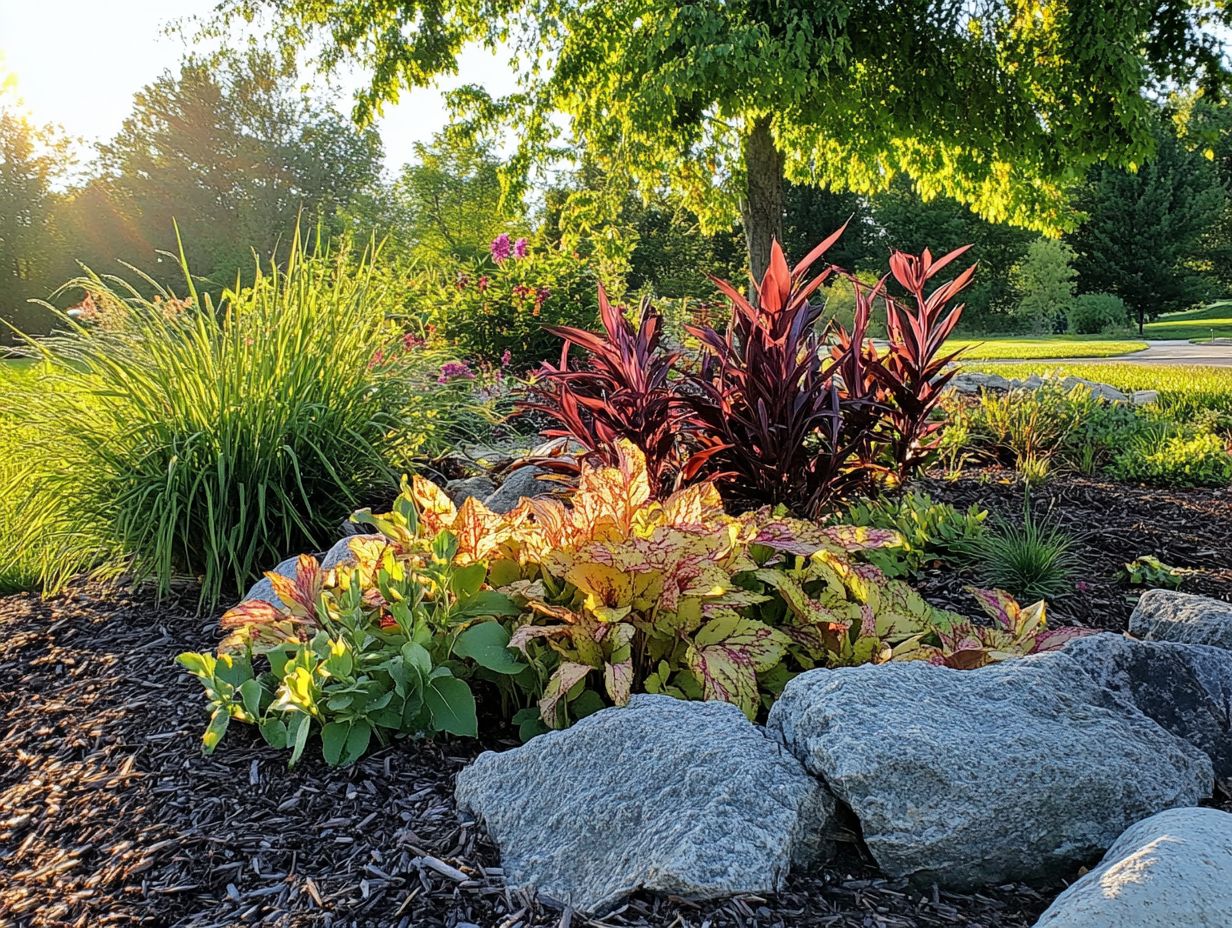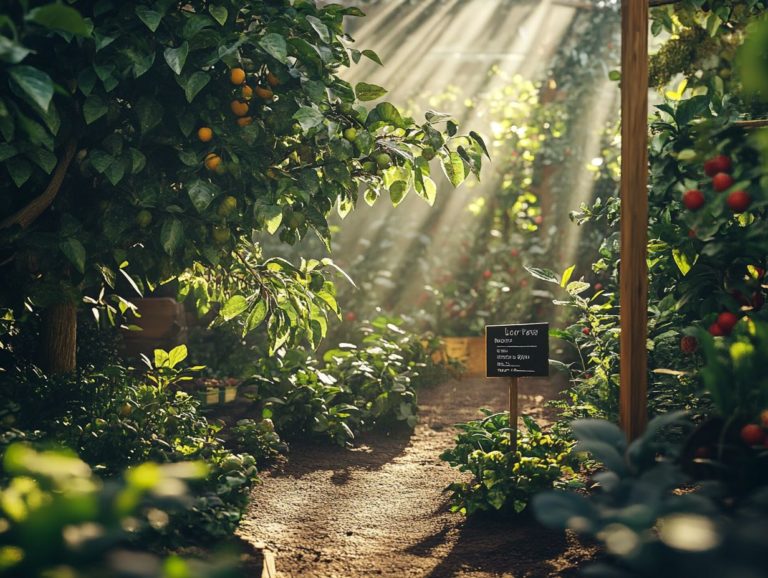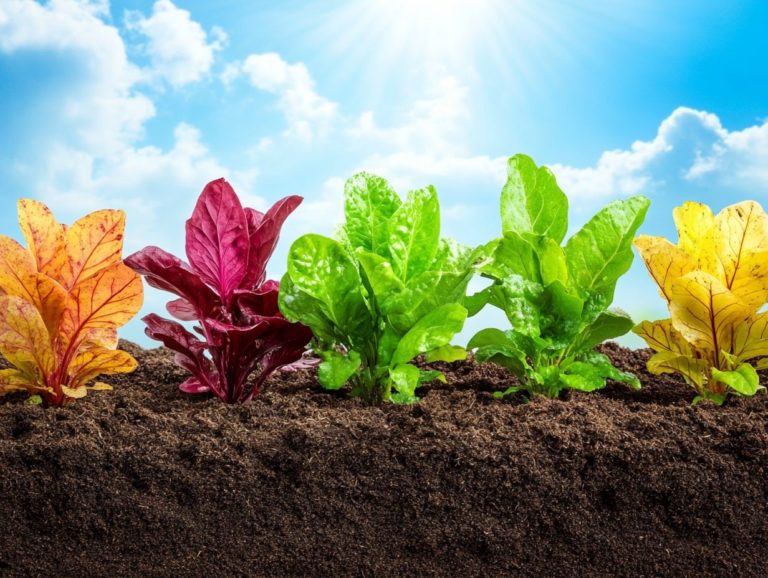“How to Choose Plants for Soil Stabilization”
Soil stabilization is essential for preventing erosion, enhancing land usability, and improving the overall environment.
Choosing the right plants is a key component of this process.
This article delves into the definition and purpose of soil stabilization, highlighting crucial factors to consider when selecting plants, including soil composition and climate.
Explore various plant types that are ideal for stabilizing soils and gain practical insights on planting and maintenance to ensure your efforts flourish.
Dive into this guide! Transform your landscape into a stunning and resilient space today!
Contents
- Key Takeaways:
- Understanding Soil Stabilization
- Factors to Consider when Choosing Plants
- Types of Plants for Soil Stabilization
- Planting and Maintenance Tips
- Frequently Asked Questions
- What is soil stabilization?
- Why is it important to choose the right plants for soil stabilization?
- What factors should be considered when choosing plants for soil stabilization?
- What are some common plants used for soil stabilization?
- How do I determine the appropriate spacing and density for planting?
- Are there any plants that should be avoided for soil stabilization?
Key Takeaways:

- Choose plants that are well-suited to your specific soil composition and climate to ensure successful soil stabilization.
- Consider the characteristics and root systems of plants when making your selection, as different plants have different abilities to stabilize soil.
- Proper planting techniques and regular maintenance are essential for the long-term success of soil stabilization using plants.
Understanding Soil Stabilization
Soil stabilization stands as a vital practice for preventing soil erosion and bolstering soil retention, especially on steep slopes where the risk of erosion is heightened.
This process uses various methods and materials. These enhance soil strength and stability, fostering healthier landscapes and lowering maintenance costs.
By implementing effective soil stabilization techniques, you can protect against environmental degradation. This ensures that key elements, such as moisture retention and soil stability, are maintained.
Incorporating native plants and ground covers creates a resilient ecosystem that supports vigorous growth and enhances aesthetic charm.
Definition and Purpose
Soil stabilization refers to a range of techniques designed to prevent soil erosion, enhance soil retention, and maintain stability, particularly on steep slopes.
This process involves utilizing both organic and inorganic materials to bind soil particles together. This effectively reduces the risks of landslides and nutrient runoff. Soil stabilization is vital for promoting environmental health, as it helps uphold the integrity of ecosystems by supporting plant growth and improving water infiltration.
By reducing erosion, stabilized soil not only preserves local habitats but also prevents the loss of fertile land, which is crucial for agriculture and biodiversity. Ultimately, these efforts contribute significantly to landscape maintenance, ensuring that both natural and human-made environments remain resilient against the forces of nature.
Factors to Consider when Choosing Plants
When choosing plants for erosion control and soil stabilization, it’s essential to consider several critical factors. These include soil composition and climate conditions that influence plant growth and their effectiveness in maintaining soil stability.
Grasping the interaction between various plant characteristics like root systems and drought tolerance is vital for successful implementation across diverse garden settings.
As a result, meticulous planning and the selection of native plants that flourish in specific environments will not only enhance soil retention but also contribute to a sustainable landscape.
Soil Composition and Climate

Understanding soil composition and climate is essential when choosing plants for erosion control. These factors directly impact a plant’s survival and its effectiveness at stabilizing soil.
Different soil types be it sandy, clayey, or loamy each present unique drainage and nutrient-holding capacities which influence how well specific plant species grow in your area. When you factor in climatic conditions like rainfall patterns and temperature ranges, determining a plant’s suitability for a particular area becomes even more crucial.
By selecting native plants that have evolved alongside local ecosystems, you can significantly enhance soil retention and stability. Native species have traits that help them survive local weather extremes, reduce erosion, and foster a healthy soil structure, ultimately leading to more sustainable landscapes.
Plant Characteristics and Root Systems
Key plant characteristics, such as the nature of their root systems and drought tolerance, are critical to the success of your erosion control measures.
When considering soil stability and moisture retention, it’s essential to understand how different root structures interact. Shallow roots may provide surface stabilization but often lack the depth needed to reach vital deeper soil layers. In contrast, plants with deep, extensive root systems can effectively anchor the soil.
This anchoring not only reduces erosion along slopes but also improves how water soaks into the ground and is retained, making moisture accessible to neighboring plants. Therefore, choosing species with strong and deep root systems, along with traits like drought resistance, is vital for cultivating a resilient landscape capable of withstanding both heavy rain and extended dry spells.
Types of Plants for Soil Stabilization
Explore how different types of plants grasses, shrubs, and trees can work wonders for soil stabilization. Their unique root systems and growth characteristics work together to prevent erosion and enhance soil retention, ensuring the health and integrity of the landscape.
Grasses and Sedges
Grasses and sedges are essential in your plant selections for soil stabilization, thanks to their extensive root systems that enhance moisture retention and combat soil erosion.
These plants create a dense mat that not only protects against surface runoff but also generates organic matter, improving soil quality. Their remarkable adaptability enables them to thrive across various climates, making them an outstanding choice for diverse environments, from coastal regions to inland plains.
Take, for example, species like Blue Grama and Switchgrass, which excel in prairie and grassland settings, while Creeping Red Fescue shines in shaded areas. The robust growth patterns of these plants play a crucial role in maintaining soil integrity, nurturing a healthier ecosystem that supports both wildlife and agriculture.
Shrubs and Trees

Incorporating shrubs and trees into your soil stabilization efforts can significantly enhance erosion control, thanks to their deep root systems and their ability to provide shade and support to smaller plants.
These plants not only anchor the soil but also improve its quality by preventing nutrient runoff and promoting moisture retention. The robust roots of willows stabilize riverbanks, while dense shrubbery like junipers serves as a formidable barrier against wind and water erosion.
The presence of trees such as oaks or pines creates a protective canopy that lessens the impact of rainfall on the ground, further safeguarding the soil from being washed away. Together, these species play a vital role in maintaining ecosystem balance, fostering biodiversity, and supporting various organisms that depend on healthy soil.
Planting and Maintenance Tips
Successful planting and maintenance of plants for erosion control demand careful attention to techniques that promote healthy growth and ensure long-term soil stability. This enhances the beauty of your landscape and simplifies overall maintenance.
By preparing the site meticulously, choosing the right species, and adopting effective care routines, you can cultivate a flourishing garden filled with stunning plants that play a vital role in soil retention.
Proper Planting Techniques
Implementing proper planting techniques is essential for effective erosion control and maximizing soil retention. This leads to healthier landscapes and enhanced soil stability.
To achieve optimal results, start with thorough site preparation. Clear any debris, test the soil quality, and improve drainage as needed.
Pay attention to the spacing between plants; it can significantly reduce competition for nutrients and water, fostering healthier growth.
Choosing the right planting method whether direct seeding or transplanting seedlings also plays a pivotal role in establishing a robust root system that binds the soil together.
By adhering to these best practices, you create a resilient landscape that elevates aesthetic appeal while mitigating erosion, preserving environmental integrity in the process.
Regular Maintenance and Monitoring
Regular maintenance and monitoring of your erosion control plants are crucial for ensuring their effectiveness in stabilizing soil and maintaining the overall health of your landscape.
This involves essential practices like ongoing watering, which helps plants establish robust root systems, and timely pruning to encourage healthy growth and airflow.
Stay vigilant in checking for pests or diseases to prevent potential threats that may undermine the integrity of your plants.
Incorporating these maintenance routines enhances the resilience of the plants themselves and significantly boosts the success of your erosion control efforts. Consistent care is the secret ingredient to cultivating a thriving environment capable of withstanding erosion long-term.
Frequently Asked Questions

What is soil stabilization?
Soil stabilization improves soil properties to make it more stable and able to support structures or plants.
Why is it important to choose the right plants for soil stabilization?
The right plants can prevent erosion, promote healthy soil, and improve ground stability, making it suitable for construction or other uses.
What factors should be considered when choosing plants for soil stabilization?
Consider the type of soil, climate, amount of sunlight, water availability, and the purpose of stabilization, such as erosion control or structural support.
What are some common plants used for soil stabilization?
- Grasses
- Shrubs
- Trees with deep root systems
- Ground cover plants like clover, sedges, and mosses
- Flowering ground covers like Vinca Minor and Creeping Phlox
How do I determine the appropriate spacing and density for planting?
The recommended spacing and density for planting depend on the soil and specific plant species used. It is best to consult a professional or conduct research to find the ideal spacing for your situation.
Start your planting journey today and explore specific plants that can help stabilize your soil!
Are there any plants that should be avoided for soil stabilization?
Yes, some plants can harm soil stability. Avoid those with shallow roots or those that spread quickly, as they can damage surrounding areas.
Always research before choosing plants for soil stabilization. This will help you select the best options for a healthy environment.






